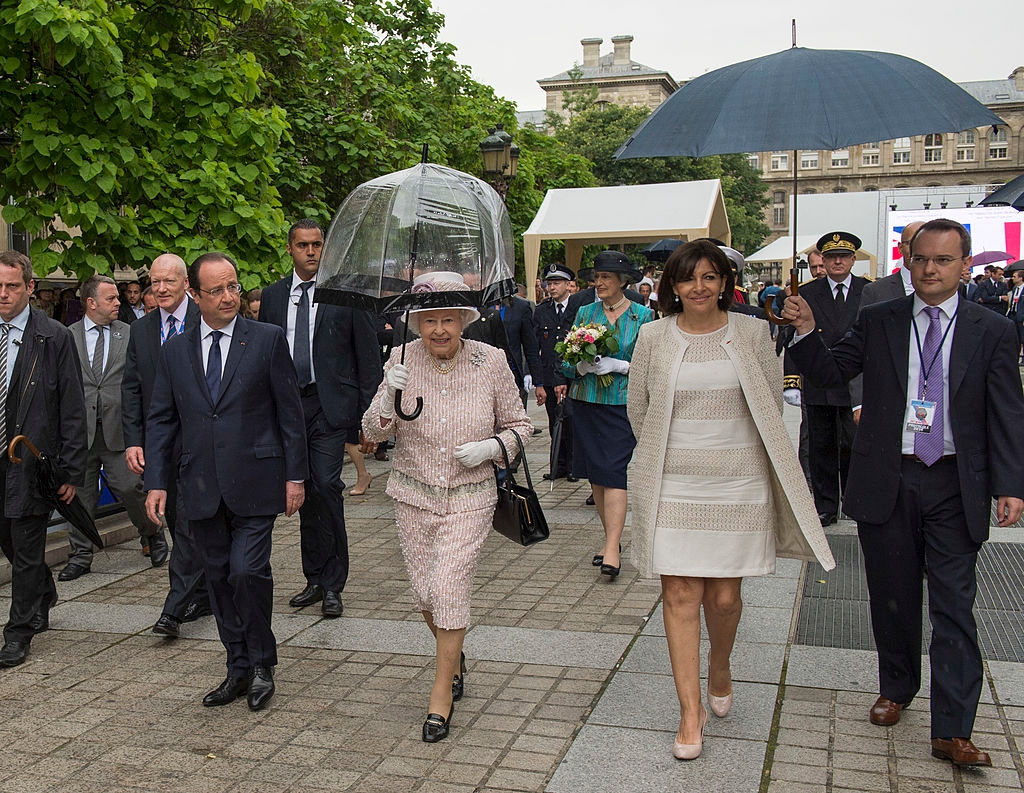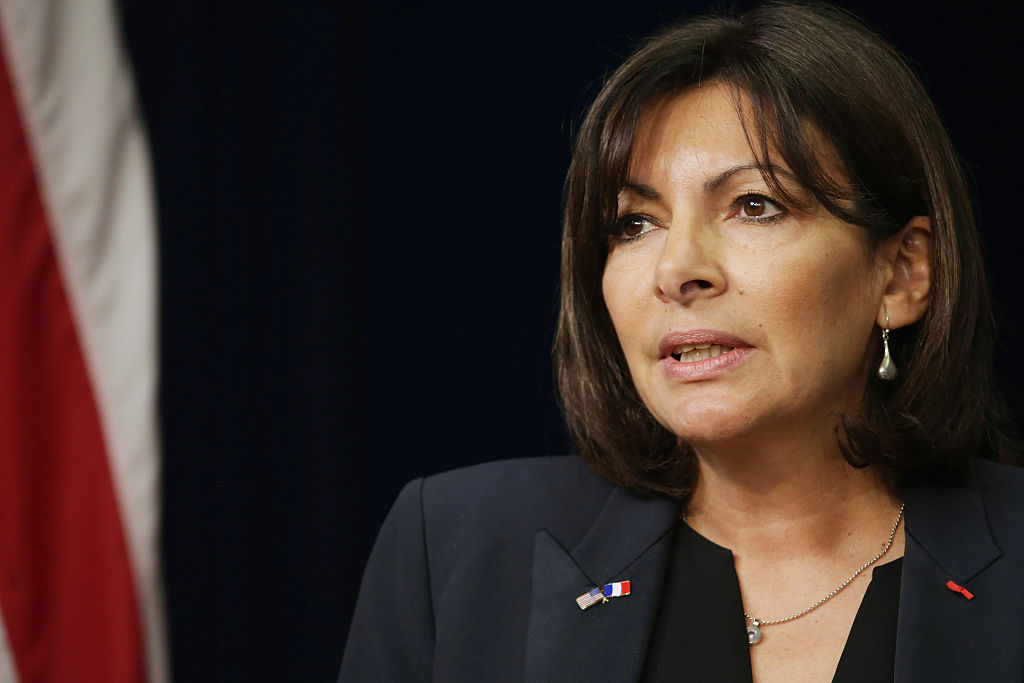A photograph, taken in June 2014, has become emblematic of Anne Hidalgo’s Socialist rule of Paris. In the picture stands Queen Elizabeth II, then 88, in Paris to unveil a plaque at the Marché aux Fleurs, near Notre-Dame. The Queen, in addition to her usual black handbag, carries her own plastic umbrella. Next to her, the newly-elected mayor, dressed in a cream outfit, has her hands free while a city official holds a large umbrella above her perfect blow-dry.

The Spanish-born Hidalgo, 62, now about to announce her candidacy for the 2022 presidential election, is a woman untouched by self-doubt. Any criticism of her stewardship of the capital — where she was reelected last year, between lockdowns, by only 17 percent of registered voters — she ascribes to an ‘extreme-right cabal’. A close protégée of the former president François Hollande, Hidalgo has adopted his capacity to block out criticism and his skill at machine politics, even among the ruins of France’s shattered left.
But the City of Lights is today demonstrably dirtier, uglier, more dangerous, and harder to navigate than when Hidalgo came to power. Since last winter, Parisians have expressed their mounting outrage at the state of the city on social media, posting pictures with the hashtag #saccageparis (#wreckingparis).
There are photos of overflowing trash cans (‘Parisians are dirty’, the mayor explained); crabgrass and bald patches replacing carefully-tended flowerbeds and lawns (‘watering plants is ecologically dispendious’ according to a Hidalgo deputy); videos of rats under tunnels or on the banks of the Seine (no comment); littered squares of earth at the base of the city’s trees replacing the 19th century rose-shaped wrought iron protective grilles (‘the city encourages Parisians to plant and tend vegetation in these newly-freed spaces’); huge concrete girders to be used as seats installed in historic squares while the city’s classic dark green benches are left or sold off (‘Paris is beautified every day by contemporary design’); and, everywhere, more concrete, in rough blocking barriers, painted yellow and abundantly graffitied, disfiguring major thoroughfares like Avenue de l’Opéra or Rue Royale under the guise of ‘materializing’ cycle lanes.
The vandalism of Paris under Hidalgo’s reign does not stop there. Ubiquitous white and yellow striped plastic bollards have been added everywhere to ‘canalise’ (reduce) traffic. So have huge trash-sorting dumpsters, ruining some of the prettiest streets in the capital. The mayor, who hates cars and wants to block them off entirely from the five central arrondissements under the programmatic ‘Paris Breathes’ slogan, has used the mega-trashcans as part of her goal of halving the number of parking places in the city. Official studies have found that instead of reducing pollution, the closing-off to traffic of entire avenues like Rue de Rivoli, from the Louvre to Place de la Concorde, as well as both banks of the Seine, may have only displaced and increased the fug: the mayor disregards these studies.
Hidalgo’s seven-year Parisian tenure has held until now because of her tactical alliance with the city council’s Greens. She has in effect delegated her ideological line to them. Performative gestures, tainted by regular bouts of leftist vindictiveness, are the norm, such as erecting a large pre-fab homeless shelter blocking the view of the residents on Avenue du Maréchal-Maunoury, one of the most expensive streets of the 16th arrondissement. (The homeless now find themselves squeezed between an inaccessible piece of woodland shielding the Périphérique ring road, and a strictly residential area; without a Métro station in sight and the first food shop over a mile away, among one of the most expensive in Paris.)
The mayor’s initiatives are expressed in a po-faced lingo, punctuated by keywords like ‘sustainability’, ‘re-greening’, ‘inclusiveness’, ‘proximity’, ‘reenchantment’, ‘architectural gestures’, ‘responsibility’, all of which, like Soviet Five-Year Plans, bear little relation to any discernible reality.
In the past 10 years, Paris has fallen spectacularly in the red — the current debt has ballooned from $1.2 billion when Hidalgo first took over from Mayor Bertrand Delanoë in 2015, to over $9.5 billion, even as the Hidalgo administration has raised local taxes and rates by almost 30 percent. Meanwhile Paris has lost about 110,000 residents to the suburbs.
Unlike London, the city administration never absorbed its greater metropolitan area, which contains around 12 million people. City Hall blames just about anything for this flight of people out of central Paris — except its own policies.
It’s not just some of the city’s most affluent inhabitants who leave: last week BFMTV, one of France’s 24-hour news channels, interviewed residents in the Place de Stalingrad area, many of them of Muslim background. They complained of the city’s lack of pushback against hundreds of crack addicts and dealers, many of them migrants, who make life in parts of the city ‘unbearable’. (Hidalgo’s solution has been to open a number of ‘salles de shoot’, buildings where addicts can inject themselves away from the view of locals.)
Hidalgo prides herself in delivering a ‘more beautiful city’ for the 2024 Olympics; but her notions of ‘beauty’ are bizarre. On City Hall’s orders a 100-year old wisteria was sawn off last winter in Montmartre. And her Green allies have a special obsession against fountains, first drying them up, then destroying them in places such as the Rond Point des Champs-Élysées to Place de la République to Place d’Italie (where they were replaced by a shallow ‘miroir d’eau’ which soon became a soggy refuse collector. Some, like the Art Deco fountains gracing the Porte de la Chapelle, have seen parts sold off illegally. Others, like the drinking-water fountains donated by the English philanthropist Sir Richard Wallace in 1872, are almost all out of water now, while some have been ‘adapted’ to contemporary tastes with garish paint-jobs and destructured bases.
Ahead of the Olympics, Hidalgo plans to reduce vehicle access to most of the sporting stadiums. This comprises closing off the entire space from the Eiffel tower to the Trocadéro, including the current Pont d’léna, to be remade as a Flower Bridge. The city’s historic center from Place de la Concorde to the Louvre will also be pedestrianized (‘Forget completely the notion of crossing Paris from east to west’, the mayor has said), and to crown it all, the Champs-Élysées will be reduced to two lanes, by dotting the entire area from the Arc de Triomphe to the 1755 Ange-Jacques Gabriel-designed Place de la Concorde with clumps of trees and various supposedly tourist-and Instagram-friendly concrete dais.
This last project, supposedly the choice of the avenue’s commercial tenants, but blessed by the mayor herself, has been portrayed in a CGI video by the architects hoping to benefit from the lions’ share of the $276 million remodel. This has roused the ire of a number of personalities, including the former judge and political commentator Philippe Bilger who in Causeur magazine called it ‘deconstruction for deconstruction’s sake — to break order and coherence, to degrade harmony, to eradicate everything that makes sense or reveals beauty, therefore a privilege, in other words an injustice.’ The five-mile historic vista running from the Louvre to La Défense would be blocked off to the eye. The avenue itself would lose its historic paving stones and be paved over with concrete lozenges.
With that kind of record, a Hidalgo presidential candidacy might looked doomed. Some of the mayor’s staff, currently putting the last touches to her platform, are rumored to have cynically suggested a pause in her more monumental Paris remodeling efforts. And French public opinion has been skewing conservative in every poll for almost a decade. But with a left in disarray; splintered by Emmanuel Macron’s cherry-picking of its more notable personalities, and with the extreme identity politics preached on its hard-left side, the publicity-obsessed Hidalgo — whom polls show losing even against Marine Le Pen in a hypothetical second round — believes that she can embody a middle ground of sorts, if not this time, the next.
This article was originally published on The Spectator’s UK website.


















